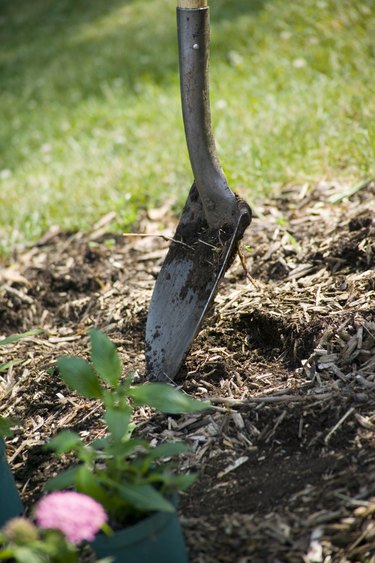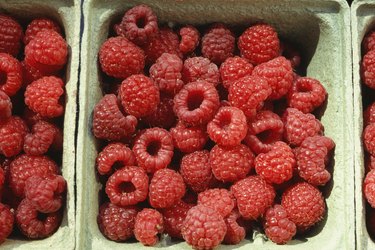
Plump, juicy, fresh-picked raspberries are prized for their versatility. They magically convert breakfast cereal into savory memories, contribute elegance to chocolate mousse and are savored when eaten straight from the plant. Summer heat often discourages Texas gardeners from growing raspberries, but it shouldn't thwart adventurous gardeners from growing this tasty fruit. Texas' greatest raspberry-growing obstacles include climate and soil diversity, although thoughtful plant selection and placement overcomes these concerns.
Soil Modifications
Video of the Day

Raspberries thrive in rich, organic, well-drained moist soil but perfect conditions rarely exist in Texas. The diversity of Texas soils requires creative gardening and soil modification when growing raspberries. Organic compost added to the soil improves aeration, drainage and water-holding capacity. Adding 3 to 4 inches of mulch protects the surface and minimizes water loss and soil temperature fluctuations. Soil needs to be slightly acidic with a pH between 5.5 and 6.5 and well-drained. Consider providing afternoon shade such as a well-placed pecan tree.
Video of the Day
Diversity of the Texas Climate
Climatic conditions prove more diverse that the soil types. In the Texas Panhandle, temperatures in Amarillo average a low of 23 and high of 51 degrees Fahrenheit in January and an average low of 65 and high of 92 in July, while Houston, near the Gulf of Mexico, averages a low of 45 and high of 63 in January and a low of 76 and high of 93 in August. The Panhandle experiences cold, strong winter storms as well as intense summer heat and drought, while southern coastal areas endure soupy, humid, rot-producing summers with periodic heavy rains. Interior areas are hot March through October with unpredictable weather. U.S. Department of Agriculture plant hardiness zones in the state range from 6a to 10a.
Best Texas Cultivar

"Dorman Red" Raspberry (Rubus idaeus "Dorman Red") is the top cultivar for Texas, but requires attention. This self-pollinating plant bears large, firm, somewhat fuzzy, sweet red berries. Suppliers claim these grow in USDA zones 4 through 8, although gardeners in Houston (zone 9) profess to growing this with careful site preparation. In thin-soiled areas of the Panhandle or the rocky hill hountry west of Austin and San Antonio raised beds offer growing advantages. Sandy acidic soil is considered ideal. "Dorman Red," developed at Mississippi State University, is described as heat-, drought- and disease-resistant. If your hope is for several baskets of raspberries from your Texas garden, follow Doug Welsh's advice in the "Texas Garden Almanac" -- "Dorman Red" is the only reliable raspberry in Texas heat.
Cultivars for Texas USDA Zones 6 to 8

Gardeners who miss the flavor of homegrown raspberries often satisfy their cravings by substituting with blackberries. However, there are some raspberry cultivars ideal for northern portions of Texas. "Oregon 1030" (Rubrus idaeus "Oregon 1030") is best suited to USDA zones 6 to 8. "Southern Bababerry" (Rubus idaeus "Southern Bababerry") requires nurturing during seasonal temperature and moisture fluctuations and is best grown in zones 6 to 8. It benefits from afternoon shading and raised beds with well-drained soil. "Sumner" (Rubus idaeus "Sumner") is occasionally recommended for Texas' USDA zones 6 to 8, but this plant tends to rot in summer heat regardless of whether it's an arid or humid year. Cultivars "Autumn Bliss" (Rubus idaeus "Autumn Bliss") and "Heritage" (Rubus idaeus "Heritage") both produce in north Texas. Both require full sun, although in zone 8 light afternoon shading is urged.
Worthy Cultivar for South Texas
"Caroline" everbearing (Rubus idaeus "Caroline") is a commonly grown Florida cultivar that thrives in USDA zones 5 to 9. It is sweeter than "Dorman Red" that easily handles the Florida heat and humidity and can be grown in south Texas. Soils in Florida are sandier than Texas and need modifying, as the heat and humidity combination in Florida is insignificantly different from the Texas Gulf Coast climate.
- Edible Landscaping.com: Caroline Everbearing Raspberry
- Ran Pro Farms: Dorman Red Raspberry
- Smart Gardener: Plant Guide Raspberry Southern Bababerry
- Texas Average and Record Temperatures
- Texas Almanac.com: Soils of Texas
- University of Arkansas Division of Agriculture Cooperative Extension: Raspberry Production for the Home Garden
- National Gardening Association: Raspberry Essentials
- University of California - California Garden Web: Raspberries
- Collin County Texas Agrilife Extension: Fruits, Nuts & Berries
- National Gardening Association: USDA Hardiness Zone Finder
- Organic Gardening Learn and Grow: How to Grow Raspberries